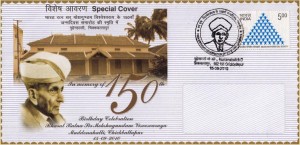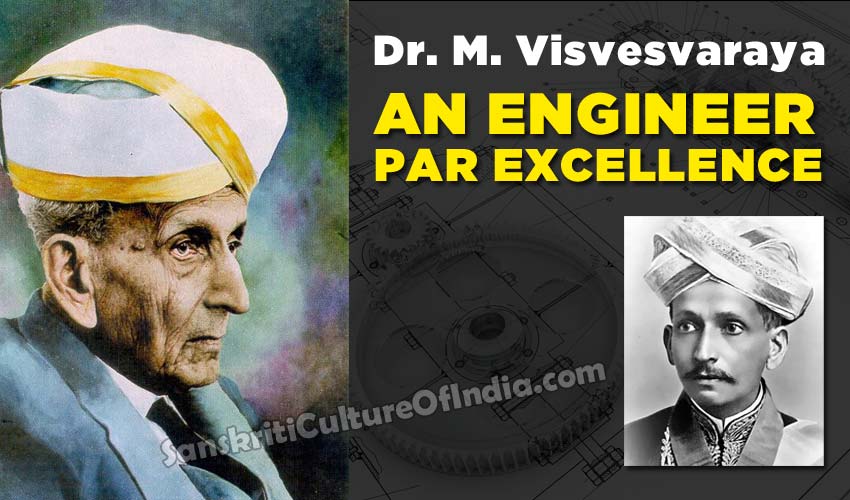“Remember, your work may be only to sweep a railway crossing, but it is your duty to keep it so clean that no other crossing in the world is as clean as yours””
On the 15th of September 1861, more than a century ago a little boy was born in Muddenahalli in the Chikkaballapur Taluk of Kolar District (Mysore State). His father Srinivasa Sastry and his mother Venkachamma named him Visvesvaraya.
Visvesvaraya’s father, Srinivasa Sastry was a great Sanskrit scholar of those days. Both he and his wife were good and pious folk who led a very simple life. They were not very well off but both his parents decided to educate the little boy. Right from his childhood days, Visvesvaraya learnt from them a respect for the culture and the traditions of the land. His father enrolled him in a school in their tiny Taluk itself and Visvesvaraya completed his early education there.
 He was a good and a hardworking student and was keenly interested in pursuing his studies. So with his parents consent and blessing he set out to Bangalore in order to go in for higher education when he was around fifteen years old. In Bangalore, he joined the Central College.
He was a good and a hardworking student and was keenly interested in pursuing his studies. So with his parents consent and blessing he set out to Bangalore in order to go in for higher education when he was around fifteen years old. In Bangalore, he joined the Central College.
But alas! His pocket was empty and he had no roof over his head. But this helpless state did not bog Visvesvaraya down. Instead he started looking for a job that would sustain him and pay for his studies. He found a family from Coorg, who was looking for a tutor for their children. Visvesvaraya, himself a student at that time, became their tutor. He lived with them and earned a few rupees with which he completed his education. As a student he earned every rupee by hard work.
Discipline was ever his watchword. All through his student days he worked hard and in a systematic way. He was an early riser and started his work quite early. Though he was poverty-stricken, he continued to study well and stood high in the B.A. Examination. When he was twenty, he managed to get some help from the Government of Mysore and joined the Science College in Poona to study Engineering. Three years later, by sheer determination and hard work he ranked first in the L.C.E. and the EC.E. Examinations (these were like the B.E. Examination of today).
As soon as the results were out, the Government of Bombay offered him the post of an Assistant Engineer at Nasik. Visvesvaraya was very happy and he worked hard and excelled in his post. When he was 32 years old, some very difficult work fell to his lot. He was given the task of finding a way of supplying water from the river Sindhu to a town called Sukkur. He prepared an ingenious plan, which amazed the other famous engineers.
Also, he developed a new system called the Block System where he devised steel doors; these could stop the wasteful flow of water in dams. Even British officers of those times were astonished by his brains and were full of praise for the invention. The Government appreciated Visvesvaraya’s genius and work. He was promoted to higher places. From Bombay, Visvesvaraya went to Hyderabad as Chief Engineer. Here he achieved something that was simply impossible at that time.
 The river Moosa divided the city of Hyderabad into two. When rains lashed, the river was in floods and the waters of the river poured into many houses, and men and cattle were carried away. Visvesvaraya planned dams to tame the Moosa and also suggested that lovely parks should be laid out on the banks of the river.
The river Moosa divided the city of Hyderabad into two. When rains lashed, the river was in floods and the waters of the river poured into many houses, and men and cattle were carried away. Visvesvaraya planned dams to tame the Moosa and also suggested that lovely parks should be laid out on the banks of the river.
His resourcefulness earned him the position of a Chief Engineer in Mysore State. But Visvesvaraya was not just interested in buildings, roads and bridges. He saw that the people of India were then in a miserable condition. There were very few schools and only six persons out of every hundred could read and write. Many people were just farmers who depended completely on the rains for their food. He saw that ignorance, poverty and sickness plagued the people; and he wanted to bring about change.
Visvesvaraya suggested that an Economic Conference be set up to find ways of removing ignorance, poverty and sickness. As a result, very dry lands in parts the country began to smile with plenty. Visvesvaraya continued to be the Chief Engineer of Mysore for three years. In 1912 when he was 51, the Maharaja of Mysore chose Visvesvaraya as his Dewan or his chief minister.
Soon after Visvesvaraya became the Dewan, one of his relatives went to him. He asked Visvesvaraya, “Can you get me into a higher post for a better pay with your recommendation to the Maharaja?”
Visvesvaraya who was so straightforward said a plain ‘No’.
But, he was kind-hearted and as long as the relative was alive, he paid him a hundred rupees every month from his pocket.
As the Dewan, he got a car from the Government for his use. He used the Government car for government work and for his private work he used his own car. Those were days when people had to work by candlelight. He used, for official work, the stationery and the candles supplied by the Government; for his private work he used stationery and candles, which he had bought. He was such an honest man.
Once, one of his friends was advised rest after some illness. He wanted to spend some days in Bangalore. The friend wrote to him asking for a house for some days. He thought the Dewan would give him a Government Guest House, free of rent. The Dewan did give him a Government House; but as long as the friend stayed there, Visvesvaraya himself paid the rent of Rs. 250 a month. He was always neatly dressed and ready for work by seven in the morning. He was known everywhere for his discipline and tidiness. There was not a crease or a wrinkle anywhere on his clothes.
Visvesvaraya planned everything smoothly, methodically and without any hurry. Visitors who wished to see him had to write first and he would fix an hour. He was very strict about the hour fixed and no one could come late. Visvesvaraya always believed in the value of education. When he became the Dewan, there were about 4,500 schools in Mysore State. In six Years about 6,500 new school were opened. He also stressed on education for women. He made the Maharani’s College in Mysore where the first hostel for girls was also opened. He also made arrangements for the government to give scholarships to intelligent students to go to foreign countries for studies.
Visvesvaraya realized that industry was the backbone of a country. So he developed the existing industries. He also got experts from other countries to help by teaching their skills. Thus many new industries came up during his chief minister ship. He started the Sandal Oil Factory, the Soap Factory, the Metals Factory, the Chrome Tanning Factory and Bhadravati Iron and Steel Works. He was also the key in the opening of the Bank of Mysore. He also brought in many hotels into Mysore and played a major role in the laying of railway lines.
Visvesvaraya did in six years what many others could not have accomplished in sixty years. People asked each other “Is he a magician?” many a time. But for Visvesvaraya it was no magic. He always believed only in hard work. He once said,
“The curse of our country is laziness. At first sight every one seems to be working. But in fact, one-man works and the others watch him. As someone said with contempt, ‘it looks as if five men are working. But really only one- man works. One man will be doing nothing. One man will be resting. Another man will be watching them. Yet another man will be helping these three.”
Visvesvaraya was also a fearless patriot. In those days the Englishmen considered themselves the lords of the country. The Maharaja of Mysore had the tradition of holding a Durbar during the Dasara festivities every year. On the day of the Durbar, the Europeans were given comfortable chairs but Indians were required to sit on the floor. Visvesvaraya went to the Durbar for the first time in 1910. The arrangements pained him. The next year he did not attend the Durbar. When the officers of the palace made enquiries he frankly gave the reason. The very next year all the Europeans and Indians were given chairs.
Following this a British officer wrote a letter to him. In his letter he said, “In the Maharaja’s Durbar, I want a cushion to rest my feet because the chair is too high.” Visvesvaraya promptly got the legs of the chair shortened and wrote back saying – “the height has been reduced.”
 In 1918 at the age of 57, he took voluntary retirement. He went to the palace in the Government car gave the letter and returned in his own car. After retirement he went abroad numerous times, for some work or the other. Wherever he went, he had a notebook and a pencil in his hand. He made notes of any new information with which he could help the country.
In 1918 at the age of 57, he took voluntary retirement. He went to the palace in the Government car gave the letter and returned in his own car. After retirement he went abroad numerous times, for some work or the other. Wherever he went, he had a notebook and a pencil in his hand. He made notes of any new information with which he could help the country.
After his retirement when the Bhadravati Factory was in trouble, he worked as the Chairman giving advice for restoration. At that time, the Government had not decided the salary for him. It took them some years to do so but by then the Government owed him more than a hundred thousand rupees. When they finally decided to pay him, Visvesvaraya said “I will not touch a single rupee. Start an institute where boys can learn some profession.” The government followed his wish and wanted to name it after Visvesvaraya.
But he said, “Name it after the Maharaja of Mysore.” Thus the Sri Jayachamaraja Polytechnic Institute of Bangalore came about.
In 1944, an association arranged a conference where Visvesvaraya was the Chairman. The Governor of Berar, an Englishman, was to open the conference. In those days the Governors were very powerful, highly respected and obeyed. The conference was to discuss a resolution that India should have a national government. The Governor said that the resolution should not be discussed. “Otherwise,” he said, “I will not come.”
Visvesvaraya was unperturbed by the objection and said to his friends, “All right. Why wait for him? Let us go on with the conference”. Such was his commitment towards the country that he did not care even if someone powerful hindered the growth.
Because of his genius, experience and mellow wisdom people wanted to hear him and quite often he was to make speeches. Whenever he had to make a speech he would think about what he was going to say, write the speech, get it typed and weigh every word and revise it. He would revise it four or five times and give it final shape.
Once he visited a Primary School in his native village, Muddenahalli. He gave the teacher ten rupees and asked him to distribute sweets to the children. The teacher requested him saying, “Please say a few words to the children, sir,” Visvesvaraya spoke for five minutes and went away. But later he was unhappy because he had spoken without preparation. Some days later he prepared a speech and went to the school again; once again he distributed sweets to the children. Then he made his speech.
 He toiled on briskly though old age crept around him. When he was around 92 he went to Patna where he was called to study a plan for a bridge across the Ganges. The sun was cruel and the heat was unbearable. There were parts of the site to which he could not go by car. The Government had arranged to have him carried in a chair. But he refused to use the chair. He got off the car and started walking briskly much to the amazement of the rest.
He toiled on briskly though old age crept around him. When he was around 92 he went to Patna where he was called to study a plan for a bridge across the Ganges. The sun was cruel and the heat was unbearable. There were parts of the site to which he could not go by car. The Government had arranged to have him carried in a chair. But he refused to use the chair. He got off the car and started walking briskly much to the amazement of the rest.
In 1955 when he was 94 years of age, Visvesvaraya was honored and made a ‘Bharat Ratna’ or the Gem of India. Even at that age he was so particular about his dressing that people who went to see him were surprised for he was so neat and tidy.
His memory even when he was almost a hundred years old remained pristine. Fifty years after he had tamed river Moosa, at the age of 97, there was a discussion about the river with certain others where some references were made to some intricate details. Visvesvaraya called a servant and, pointing to a bookshelf, said, “Bring the three or four books in the middle of the third row.” Then he opened one of them and pointed exactly to the detail under discussion on that page.
When he finally turned 100, people all over India showered their affection and respect on the Grand Old Man. The Government of India also brought out a stamp in his honor.
Somebody once said to him, “You have done great service to the country. You are like Bhishmacharya.” He replied, “You make me remember what a small man I am. What am I before Bhishmacharya?” He was so modest. Even at the age of 100, he rose to receive a visitor; he got up again when the visitor was leaving.
Visvesvaraya silently passed away on 14th of April 1962. He was 101.
Visvesvaraya led the country to the path of progress, every one of his creations were considered mighty andI magnificent. But far mightier and far more magnificent was the matchless Dreamer, Doer and leader who paved the way to modern India.
~ Priya Agarwal
Some of Dr. Visvesvaray`s Achievements:
- Architect of the Krishnarajasagara dam – or KRS or Brindavan gardens. One of the biggest dams in India which irrigates a hundred and twenty thousand acres of land. This was built at a cost of Rs 2.5 crore. It changed a barren Mandya district into rice granary, provides drinking water to Mysore and Bangalore.
- Bhadravati Iron and Steel Works – as its Chairman he rescued it from becoming extinct.
- Mysore Sandal Oil Factory and the Mysore soap factory
- Mysore University – Sir M.V.’s question was “If Australia and Canada could have universities of their own for less than a million population, cannot Mysore with a population of not less that 60 lakhs have a University of its own?”
- State Bank of Mysore (it was first named The Bank of Mysore)
- Public libraries in Mysore and Bangalore
- Encouraging girls to attend school.
- Mysore Chamber of Commerce
- Kannada Sahitya Parishad or the Kannada Literary Academy
- Sri Jayachamarajendra Occupational Institute, Bangalore – funded by the ENTIRE money [Rs 2 lacs] he earned from rescuing Bhadravati Iron Works.
- In 1912 he set up Hebbal Agricultural School, now University of Agricultural Sciences.
- In 1903 he designed automatic, weir water floodgates, installed at Khadakvasla reservoir.
- He implemented irrigation system in Karnataka.











